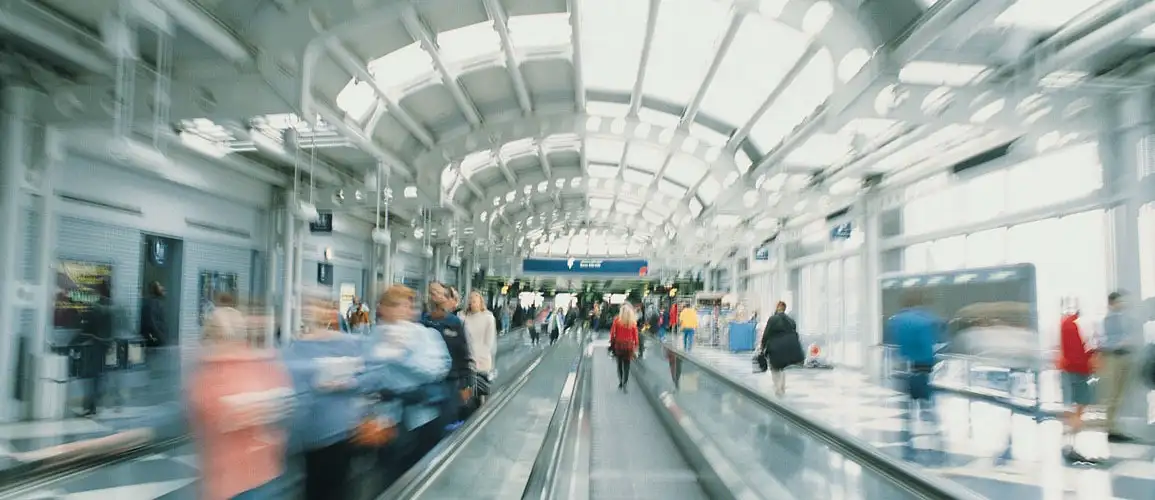
You can now travel to/from Dallas-Ft. Worth International Airport (DFW) by train. Last week, DART, the Dallas-area rapid transit system, opened the long-awaited extension of the Orange light rail line directly to Terminal A. From the airport, it runs to the central district, then turns northward again toward Richardson. Trains run frequently from 3:50 a.m. to 1:12 a.m. (12:12 on weekends). DART says that typical running time between the airport and downtown is about 50 minutes. You ride modern three-section light rail vehicles, with easy-boarding, low-level floors in the central section, but they do not provide racks or other special provisions for travelers’ baggage.
Airport trains do not assess any surcharge: The regular fare is $2.50 for two hours of unlimited travel on the DART system (including transfers to other light rail lines or bus, if needed) or $5 all day. Seniors 65 or over and students pay half fare, but they require photo ID issued at the DART central office.
The airport station is in Terminal A, one of several used by American Airlines. Travelers on American flights departing from other terminals can check baggage and pass through security at Terminal A, then use the airside “Skylink” people-mover to reach Terminals B, C, D, and E. Travelers on other airlines should use the “Terminal Link” bus from the DART station to their terminal.
All in all, Dallas riders should find the new Orange line service much more user-friendly than the current connecting system of Trinity Rail Express (TRE), with less-than-hourly trains from Union Station to the CentrePort/DFW station, plus a long shuttle bus connection. For Ft. Worth travelers, however, TRE is still the only rail option.
DART also provides indirect service to popular, close-in Love Field, but it’s more cumbersome: Orange or Green line to the Inwood Station, then a shuttle bus to the terminal. Love Field is so close to the center of Dallas that most folks will probably just use a taxi. Dallas has some plans for a new Love Field station with an underground people-mover to the terminal.
DFW joins the growing list of big U.S. and Canadian airports with rail access to/from the city center:
- Suburban or Metro direct to terminal: Atlanta, Chicago/O’Hare, Chicago/Midway, Cleveland, Philadelphia, San Francisco, Vancouver, and Washington/Reagan National.
- Light Rail direct to terminal: Baltimore, DFW, Minneapolis-St. Paul, Portland, Salt Lake City, Seattle-Tacoma, and St. Louis.
- Suburban, Metro, or light rail to station near airport plus people-mover to terminal: Oakland, Miami, New York/JFK, Newark, and Phoenix.
- Suburban, Metro, or light rail to station near airport plus shuttle bus: Boston, Burbank, Dallas/Love, Ft. Lauderdale, San Jose, plus Milwaukee and Montreal with infrequent rail service.
- Rail direct to airport in construction or advanced planning stage: Denver, Los Angeles, Honolulu, Orlando, Toronto, and Washington/Dulles.
That still leaves lots of busy airports without existing or in-progress rail access, including: Austin, Calgary, Charlotte, Cincinnati, Detroit, Edmonton, Houston/Bush, Houston/Hobby, Kansas City, Las Vegas, Nashville, New Orleans, New York/LaGuardia, Pittsburgh, Sacramento, San Antonio, San Diego, and Tampa.
The U.S. and Canada are late to the game in airport rail access, compared with major cities in Asia and Europe, where rail access is fairly common even at smaller airports. Among the few important European visitor airports that still lack direct terminal rail access are Budapest, Dublin, Glasgow, Marseilles, Naples, and Nice. On the other hand, several world airports are so far from the central city that rail is the only reasonable option, including Beijing, London/Gatwick, London/Luton, London/Stansted, Milan/Malpensa, Seoul/Incheon, Stockholm, and Tokyo/Narita.
The main problem with rail access in the U.S. and Canada is that systems typically do not provide baggage racks and other features designed specifically for air travelers. You often can’t find a good place for your baggage, and you may be caught in crowded trains during rush-hour periods. Still, bus, car, and taxi service is also congested during those times, too; I always enjoy sailing past stalled traffic on the Kennedy Expressway while riding the CTA Blue Line to O’Hare at 5 p.m. You would, too.
Ed Perkins on Travel is copyright (c) 2014 Tribune Media Services, Inc.
You Might Also Like:
We hand-pick everything we recommend and select items through testing and reviews. Some products are sent to us free of charge with no incentive to offer a favorable review. We offer our unbiased opinions and do not accept compensation to review products. All items are in stock and prices are accurate at the time of publication. If you buy something through our links, we may earn a commission.
Related
Top Fares From
Today's Top Travel Deals
Brought to you by ShermansTravel
Shop and Save with Country Inns...
Patricia Magaña
 Hotel & Lodging Deals
Hotel & Lodging Deals
$229 -- Chicago: Discounted Rates and...
Francesca Miele
 Hotel & Lodging Deals
$229+
Hotel & Lodging Deals
$229+
$188 -- Honolulu: Save on Oceanview...
Abigail Lamay
 Hotel & Lodging Deals
$188+
Hotel & Lodging Deals
$188+



